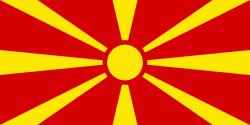Tetovo
 |
 |
Tetovo was founded in the 14th century on the place of the ancient town of Oaeneon.
In the 15th c. AD, Tetovo came under Ottoman rule for about five centuries. For a short period of time during the 15th century, Tetovo came under the control of the Albanian state, League of Lezhë led by Gjergj Kastrioti Skanderbeg and the Albanians achieved a victory over the Ottomans in the Battle of Polog. After its conquest by the Ottomans, most of city's population converted to Islam and many Ottoman-style structures were built, such as the Šarena Džamija and the Arabati Baba Teḱe, which still stand as two of Macedonia's most significant landmarks of its Ottoman period. During this period, the town belonged to the Vilayet of Kosovo, became a firearm and cannon foundry, and was renamed Kalkandelen (meaning Shield Penetrator); as a result, the town attracted many workers and grew to a city. Following the World Wars, Tetovo became a part of Yugoslavia and, later, the Republic of Macedonia.
Tetovo has become the unofficial capital and centre of a predominantly ethnic Albanian region which extends in an arc from Tetovo to Struga. Over one-third of the city is inhabited by ethnic Macedonians. Tetovo historically had a large Turkish population, forming nearly one-quarter as recently as 1961, though it now makes up under 4% of the city.
South East European University, North Macedonia's third largest university after Skopje and Bitola, is located in Tetovo. Tetovo is also home to the State University of Tetovo.
In early antiquity, Tetovo was first mentioned as Oaeneum (Ωαινέον in Ancient Greek). The region was referred to as Htetovo in a Serbian Charter. During the Ottoman rule the name of the town was Kalkandelen.
Map - Tetovo
Map
Country - Republic_of_Macedonia
 |
 |
The region's history begins with the kingdom of Paeonia, a mixed Thraco-Illyrian polity. In the late sixth century BC, the area was subjugated by the Persian Achaemenid Empire, then incorporated into the Kingdom of Macedonia in the fourth century BC. The Roman Republic conquered the region in the second century BC and made it part of the larger province of Macedonia. The area remained part of the Byzantine Empire, but was often raided and settled by Slavic tribes beginning in the sixth century of the Christian era. Following centuries of contention between the Bulgarian, Byzantine, and Serbian Empires, it was part of the Ottoman Empire from the mid-14th until the early 20th century, when, following the Balkan Wars of 1912 and 1913, the modern territory of North Macedonia came under Serbian rule.
Currency / Language
| ISO | Currency | Symbol | Significant figures |
|---|---|---|---|
| MKD | Macedonian denar | ден | 2 |
| ISO | Language |
|---|---|
| SQ | Albanian language |
| MK | Macedonian language |
| SR | Serbian language |
| TR | Turkish language |















